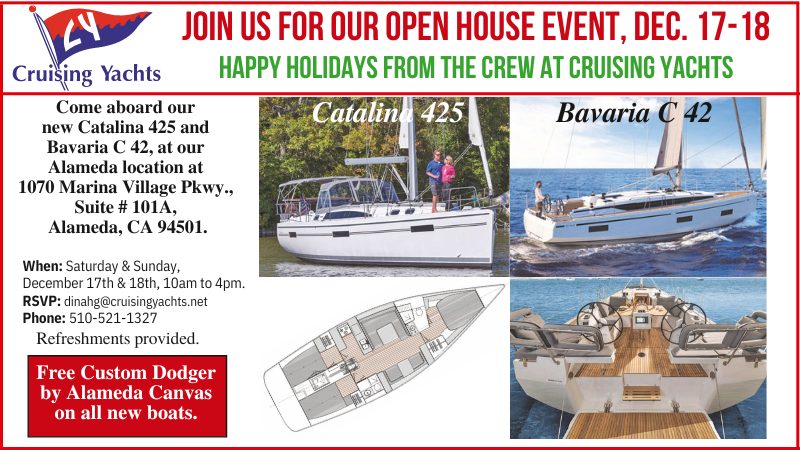
Why I Didn’t Sail on Saturday
Trans-Sierra highways closed, trees down, power failures, shoreline roads and parking lots flooded, lighted boat parades and midwinter races canceled — Saturday’s storm packed a powerful punch as it swept through California.
Berkeley Midwinters
Midwinter series on the San Francisco Bay racing schedule considered the wisdom of inviting competitors to brave the gale warnings. Berkeley Yacht Club’s policy is to automatically cancel in the event of a gale warning, and so they did. Sunday’s race proceeded as scheduled. About half of the boats registered showed up to race in the still-blustery wind and rain squalls on December 11. See www.jibeset.net/BYC000.php?RG=T004054696 for more info on the BYC Midwinters.
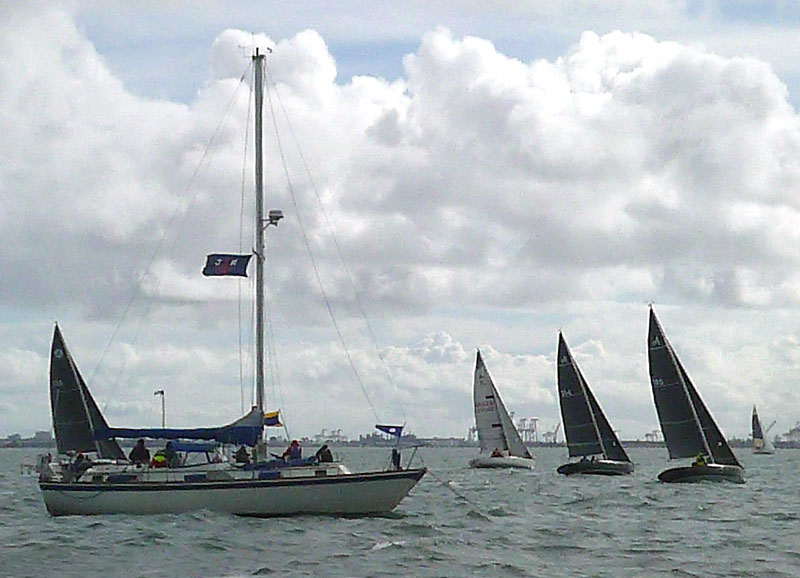
Lake Merritt
Duncan Carter, scribe for the Lake Merritt Sailing Club in Oakland, sent this message to the lake’s racers on Thursday: “Commodore Denis Hazlewood regrets to announce that the first four races of the Edna and Howard Robinson Memorial Midwinters, scheduled for December 10, 2022, are canceled because of inclement weather. Be sure to join us on Sunday, January 15, 2023, for the second scheduled race day of the series.”
Riding Out the Storm in Richmond
How windy was it? We recorded a gust of 44 knots on Saturday afternoon at Richmond Yacht Club. Thus, we were content to stay in the relative shelter of the harbor. While there, we also noted as high a tide as we’ve seen there in the past 10 years. The combo of a full moon, heavy rain, low air pressure and wind-driven fetch tossed waves over the rip-rap seawall protecting the Richmond Harbor and Potrero Reach.
Making tea in the bouncy boat wasn’t so easy!
Sausalito YC/RegattaPRO Winter One Design
Sailing a bit to the west of the Berkeley Midwinters, the RegattaPRO Winter One Design series had two races scheduled on Saturday. On Friday, PRO Forrest Gay posted this notice:
“The scheduled first warning signal for Saturday, December 10, is changed to 1300,” from 11:30.
“We have been monitoring the approaching winter storm for three days now, and all of the most reliable forecasts are currently lined up indicating that the dangerous wind in the over 25-knot range should be clear of the race area right around late morning to noon, allowing for one or two afternoon races. There will still be plenty of rain and wind likely throughout the afternoon, and the National Weather Service has a “gale warning” in place until 3 p.m., so please use caution and make the best decisions about sailing and racing amongst your crew. Reminder: RRS Rule 3 states, ‘The responsibility for a boat’s decision to participate in a race or to continue racing is hers alone.’ The sailing instructions do not allow for signals to be made ashore, so any further postponements deemed necessary after 1300 will be made on the water.”
Forrest is filling in for the usual PRO of the series, Jeff Zarwell, while Jeff recovers from a medical procedure. “Forrest was acting PRO and made a great call to change the starting time to 1 p.m.,” commented J/105 sailor Tim Russell. “The storm passed through and winds died, and we had two short races in 15-20 knots of breeze and a couple of showers. Five J/105s showed up and one Moore 24. We were back at the dock by 4:15.”
Good Jibes #69: Clear the Decks, Batten the Hatches! Get Storm Ready (Verbatim)
Welcome to Good Jibes. This week we’re casting off with a story from the January 2022 issue of Latitude 38 Sailing Magazine, “Clear the Decks, Batten the Hatches! Get Storm Ready.” Read by fellow sailor and host Monica Grant, the story tells of Mary SwiftSwan’s response to the “atmospheric bomb” storm that wreaked havoc across the Bay in October 2021. Mary spoke with the USCG and various harbormasters to survey the aftermath along the Bay Area’s waterfront, which included 18 boats destroyed or reported with damage, one mystery-slick trace, and one boat helped with no damage — though actual numbers could be much higher. She also tells about the dramatic grounding, the rescue of the crew, and the loss of Anthem, one of the fleet at Afterguard Sailing Academy in Oakland.
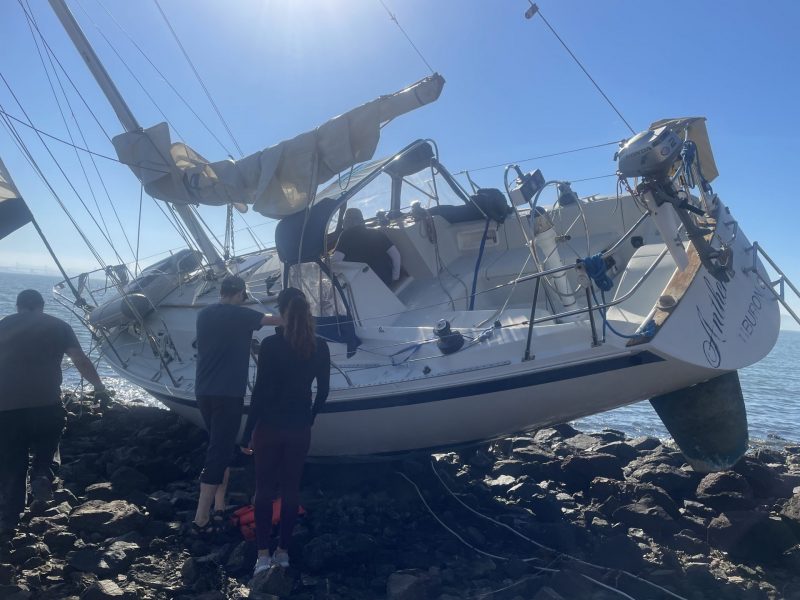
This episode covers everything from major storms to rescue missions. Here’s a small sample of what you will hear:
- How bad was the October 2021 storm?
- What boats were lost in the storm?
- How did the Coast Guard get involved?
- What’s involved in rescuing the crew?
- How do you prepare your boat for winter storms?
- What do you do if your boat blows away?
- How do you survey the damage of storms?
- Does insurance help when it comes to natural disasters?
Follow along and read the article at https://www.latitude38.com/issues/january-2022/#60.
Check out Mary’s winter-storm prep checklist and get your boat ready for this season’s winter storms.
Listen to the episode on Apple Podcasts, Spotify, Google Podcasts, and your other favorite podcast spots — follow and leave a 5-star review if you’re feeling the Good Jibes!
Cruising Yachts Open House This Weekend, Dec 17-18
Join Cruising Yachts this weekend at Marina Village for an Open House to view the new Catalina 425 and Bavaria C 42. RSVP [email protected].
Baja Ha-Ha XXVIII — Where Are They Now?
Amazingly, it’s been a month since the finish of the Baja Ha-Ha, and the fleet is now out and about, cruising Mexico. Boats have mostly gone their separate ways, with many heading up into the Sea of Cortez and others now in Mazatlán or Banderas Bay, or exploring the Mexico coastline.
We heard more from crew member William Pryor on the Jeanneau Sun Odyssey 45 Silver Linings, which appeared on this month’s cover. He wrote, “The boat cruised on to La Paz and Loreto, and has been making its way toward Bahia Concepción, which will be the most northerly point on this trip. After a crew change, the boat will head back down and plans to do the bash through the early part of January.” If all goes well, they’ll be heading to their home port in Oxnard to complete the two-month round trip, including their exploration time in the Sea of Cortez.
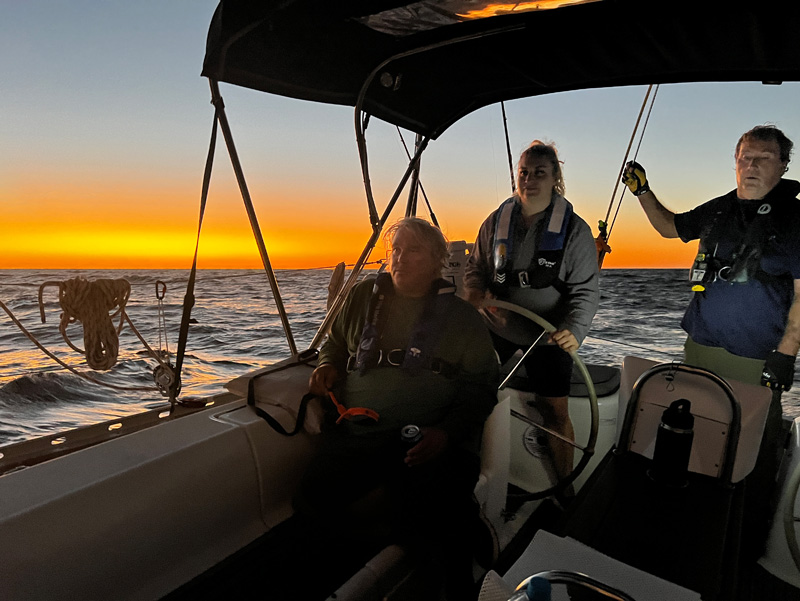
The aerial shot on the December cover was just a taste of what the drone captured throughout their whole adventure. William Pryor sent a full video compilation of their voyage to date, which shows a pretty compelling overview of why the Baja Ha-Ha is so much fun.
One more shot of Silver Linings sailing down the coast of Baja captures the idyllic sailing conditions of this year’s rally, and why a good asymmetrical cruising spinnaker is an important sail in your cruising inventory.
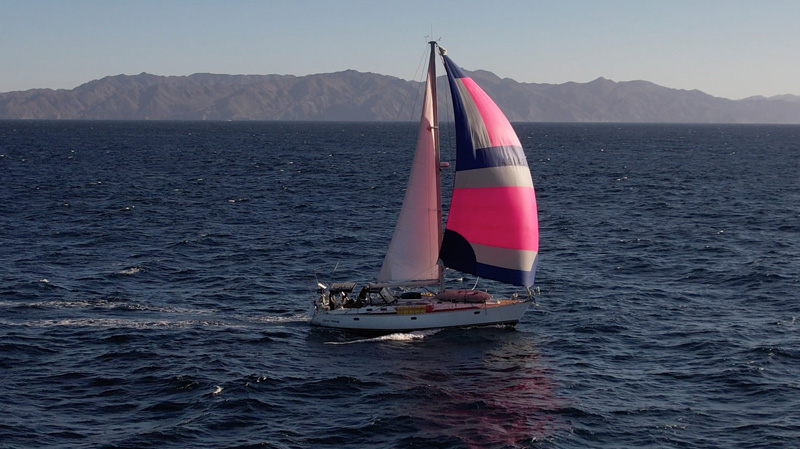
We also heard from Dave and Karen on the Bayfield 40 Dakota II from Victoria, BC, who headed toward the Sea of Cortez and reported, “We anchored in La Paz for two weeks, where we explored and played the tourist. Life is easy there and we were welcomed by the friendly cruising Club Cruceros de La Paz at Marina de La Paz. We’re now out and about, looking forward to meeting lots of other cruisers in the Sea of Cortez.” In our December Baja Ha-Ha wrap-up article they told us, “We saw our first turtle at sea — with two blue-footed boobies on its back.”
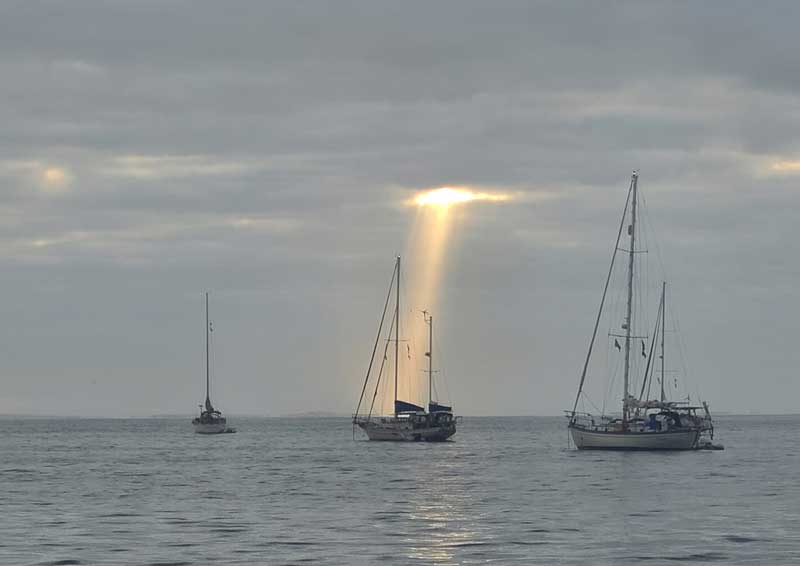
Some of the trackers are still tracking as the fleet spreads across Mexico. Nick Sands and crew from Sausalito Yacht Club aboard their Sabre 402 Escapade were sailing toward the mainland after leaving Santa Isabel, while another tracker flew home to Boise. Other fleet members headed off to Banderas Bay and participated in this past weekend’s Banderas Bay Blast and the Pirates for Pupils Spinnaker Run for Charity.
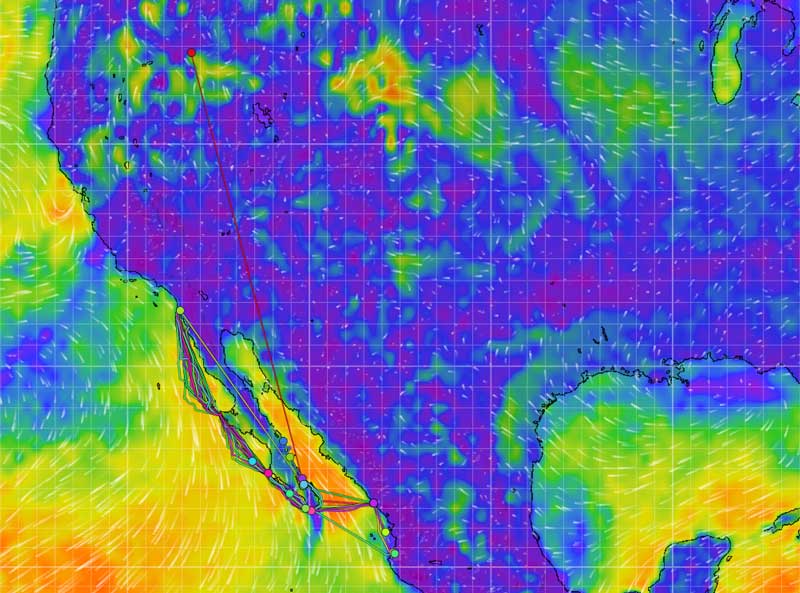
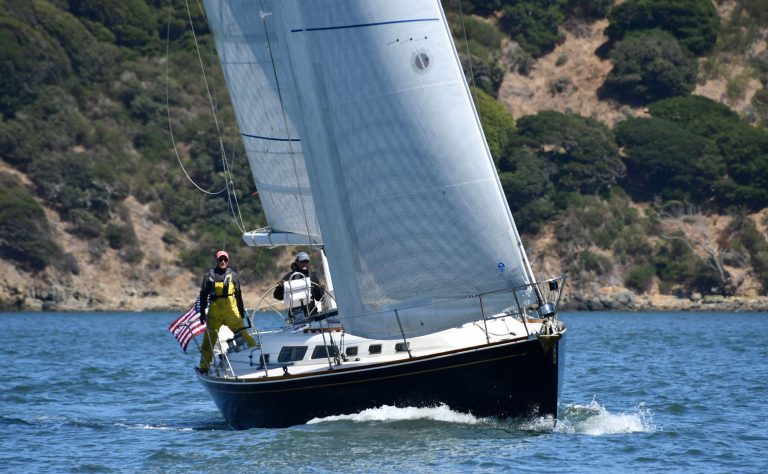
We wish all Baja Ha-Ha and Mexico cruisers fair winds as they continue their down-south adventures. There are plenty more adventures unfolding along the coast of Mexico.
The SS ‘Pacific’ Sank, But What Happened to the S/V ‘Orpheus’?
Last week we shared the story of the discovery of SS Pacific, a steamship that sank off the coast of Cape Flattery, WA, in 1875. The ship sank around 20 minutes after colliding with the S/V Orpheus, which had mistaken the Pacific‘s single masthead light for the Cape Flattery Light, and ultimately crossed the Pacific‘s bow and put herself in the path of the inevitable collision. One of our readers, Jeff, asked, “What happened to the Orpheus?”
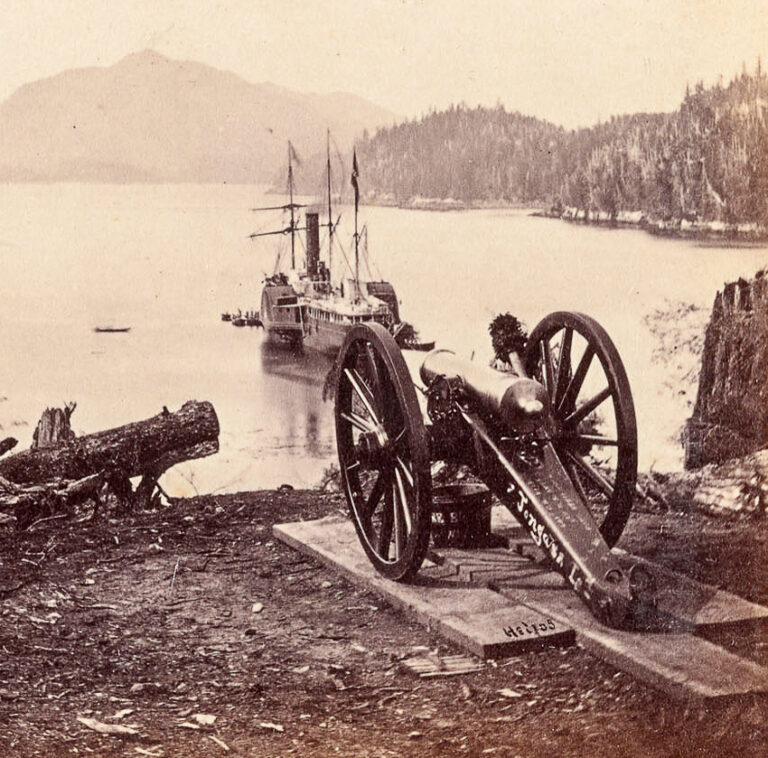
S/V Orpheus was a 200-foot, wooden-hulled sailing ship built in 1856, in Chelsea, Massachusetts. At the time of the accident, Orpheus was in use as a trading ship running along the Pacific Coast. On this occasion, under the command of Capt. Charles A. Sawyer, and carrying a crew of 21, she was sailing from San Francisco to Nanaimo, B.C. It was her second trip along the coast of Washington to Vancouver Island.
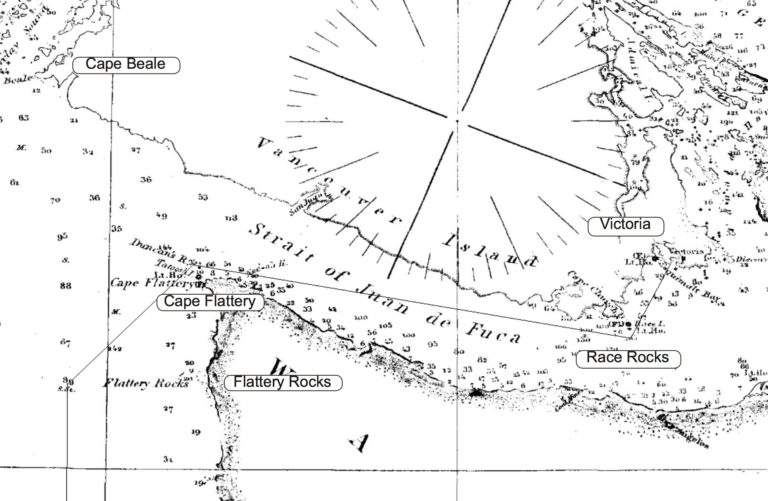
According to the account written by Daryl C. McClary on HistoryLink.org, the ship also carried the captain’s wife. The story goes: “Just before the collision, Captain Sawyer’s wife, Lillian, came on deck and together they watched the accident unfold. He hailed the steamer to stand by, but there was no reply. Sawyer’s wife was outraged by the incident and attempted to board the offending vessel before they drifted apart, but Sawyer restrained her.”
As the ships went their separate ways, Capt. Sawyer turned his attention to saving the Orpheus. As it turned out, the ship had not suffered severe damage and was able to set a few sails to help her navigate through the heavy weather while the crew carried out repairs. The next night the Orpheus continued her journey toward the Strait of Juan de Fuca, but she had moved too far north, and the lighthouse now seen by the captain was not Cape Flattery, but the newly built light at Cape Beale. Early the next morning the Orpheus ran aground on Tzartus Island, in Barkley Sound, Vancouver Island. While there were no casualties, the ship itself was lost.
Orpheus‘s crew were all rescued, but in the days and weeks that followed investigations into the accident led to accusations against Capt. Sawyer. After being arrested in Canada, but failing to appear in court, the captain was accused of manslaughter for “leaving the scene without trying to determine what damage had been done to the Pacific.” However, the verdict was never upheld or acted upon. Later, in San Francisco, Sawyer was accused in the federal court of “barratry by ‘willfully casting away his vessel’ on Vancouver Island to destroy evidence.” This case was dismissed due to a lack of proof.
Throughout the investigations there appeared much evidence to indicate that the SS Pacific was in poor condition. “Witnesses were called from Port Townsend who testified the Pacific‘s hull was rotten and she leaked badly.” Furthermore, a segment of the Pacific‘s bow that was found in Orpheus‘s rigging supports the belief that she was in poor condition. Would the Pacific (and her 300+ souls who perished) have survived the collision if she had been in better condition? It’s hard to know. But perhaps when the team from Rockfish Inc. salvage her remains from the ocean floor there will be enough evidence to put together a broader picture of that moment in maritime history.
It is interesting to note that despite having full and exclusive rights to the salvage, Rockfish Inc. may yet have to share the spoils of their discovery. According to the ruling, members of the public who can prove a connection are able to “file a claim to repossess” what is salvaged.
The Weather Network reported Rockfish Inc. co-founder Jeff Hummel’s saying that “four people have contacted him claiming to be descendants of passengers on board, including one person who lives on Vancouver Island, and he hopes more come forward.”
“Different people can come forward and say, ‘I have a claim to this part of the ship,’ or ‘this part of the cargo. Here’s why; here’s my evidence,'” Hummel said. “That’s the exciting part of the story.”

